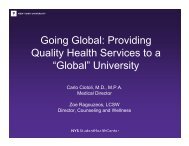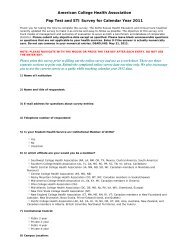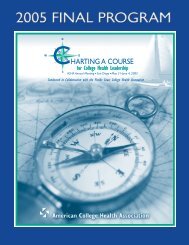Primary Prevention of Sexual Violence - American College Health ...
Primary Prevention of Sexual Violence - American College Health ...
Primary Prevention of Sexual Violence - American College Health ...
- No tags were found...
Create successful ePaper yourself
Turn your PDF publications into a flip-book with our unique Google optimized e-Paper software.
<strong>Sexual</strong> <strong>Violence</strong> <strong>Prevention</strong>By David S. Lee, MPH, Lydia Guy, BA, and Brad Perry, MA<strong>Primary</strong> prevention involves developing comprehensive strategiesthat stop violence before initial perpetration or victimization,especially those that make community and society levelchanges. The best sexual violence prevention strategies combinethe socio-political analysis <strong>of</strong> the feminist anti-rape movementand the systematic approach to promoting healthy behaviorscentral to public health theory.<strong>Prevention</strong> work focused on college-age students is animportant element to any comprehensive strategy to preventsexual violence. From a primary prevention perspective,college-age men and women are at a developmental stagewhere lifelong behaviors are shaped. Young men and womenare continuing to learn how to perform their socially influencedgender roles, and how to act out their gender-based sexualscripts. Appropriately timed prevention strategies can reducefuture sexual violence.In this article, we will review the foundations <strong>of</strong> sexualviolence prevention work. Then we will explore the use <strong>of</strong>education sessions to prevent sexual violence, and thenreview more comprehensive strategies, such as communitymobilization, changing social norms, social marketing, andpolicy work.Foundations for Preventing <strong>Sexual</strong> <strong>Violence</strong>The foundation <strong>of</strong> efforts for preventing sexual violencecome from both the feminist movement and from empirical datafrom research on associated risk and protective factors. Feministtheory understands rape as a cultural phenomenon requiringinterventions beyond the personal and interpersonal. It is thefoundation <strong>of</strong> the anti-rape movement (Rozee & Koss, 2001).Feminist theory articulates sexual violence in the context <strong>of</strong> arape culture, a complex system <strong>of</strong> beliefs that encourages malesexual aggression and supports violence against women(Buchwald et al., 1993). Interpreting sexual violence as a foreseeableconsequence <strong>of</strong> rape culture has a pr<strong>of</strong>ound effect onsexual violence prevention strategies. <strong>Sexual</strong> violence is seenas a continuum <strong>of</strong> behaviors instead <strong>of</strong> an isolated, deviantact. Feminist models <strong>of</strong> sexual violence hold that it is notinevitable, and can be prevented by making changes to societalnorms surrounding sexuality, violence, gender, and oppression(hooks, 1989).Research has identified risk factors for individual victimization,such as being female and having experienced past sexualvictimization. Risk factors for individual perpetration includebeing male, having coercive sexual fantasies, hostility towardswomen, a history <strong>of</strong> childhood sexual victimization, growingup in an emotionally unsupportive family environment, andadherence to societal norms supportive <strong>of</strong> sexual violence,male superiority, and male sexual entitlement (Jewkes, Sen, &Garcia-Moreno, 2002). However, little is currently knownabout protective factors that may reduce vulnerability to victimizationand risk for perpetration, or environmental factors thatmay contribute to prevalence. Notwithstanding, promotingprotective factors and addressing negative social and environmentalcontributors are important components <strong>of</strong> a publichealth approach to prevent sexual violence (NCIPC, 2006).Preventing <strong>Sexual</strong> <strong>Violence</strong> Before It OccursOver the last 30 years, most anti-sexual violence effortshave been responses after the sexual violence or efforts to promoteawareness <strong>of</strong> sexual assault and resources available tosurvivors <strong>of</strong> sexual violence. To address sexual violence preventionin a truly comprehensive manner, strategies to prevent itsinitial perpetration and victimization (primary prevention) mustreach the same level <strong>of</strong> efficacy and adoption as programsthat respond to its consequences.Public health theory also advises that sexual violence preventionefforts be specific to an intentional audience. Audiencescan also be categorized by their likely role in an act <strong>of</strong> sexualviolence: as potential victims <strong>of</strong> the violence (Rozee & Koss,2001), as potential perpetrators <strong>of</strong> the violence (Clinton-Sherrod,et al., 2003), or as potential bystanders who have an opportunityto prevent or intervene in the act (Banyard, Plante, &Moynihan, 2004).Educational SessionsEducational sessions are perhaps the most commonly recognizedform <strong>of</strong> sexual violence prevention work, and thereare a wide variety <strong>of</strong> prevention curricula (see Morrison, et al.,2004 for a review). The goal <strong>of</strong> primary prevention educationsessions is to prevent first-time perpetration or victimizationby improving knowledge and attitudes that correspond to theorigins <strong>of</strong> sexual violence (such as adherence to societal normssupportive <strong>of</strong> sexual violence, male superiority, and male sexual7



![Final Program [5.4MB pdf] - American College Health Association](https://img.yumpu.com/49022356/1/190x245/final-program-54mb-pdf-american-college-health-association.jpg?quality=85)












